The burning of Dol – Paljenje dola
This week: De-nailing; Sand gets everywhere; Hard going; Finally, some progress; The burning of Dol – Evidence of the fire; Only two left; Looking back;

The blog is late this week due to some technical problems with the server where it is hosted.
After several hours of trying to log in and finish the text, I eventually gave up on Saturday night.
After starting again on Sunday morning, things seem to be back to normal, fingers crossed!
This has been another week when I have done just a little weeding in the orchards and a lot of work in the Konoba.
There is still an awful lot more work to do before the room will be finished. I had a run down to Jelsa to get some things from the builders merchant there and called at the brand new Plodine supermarket that opened last week.
It really doesn’t have much more to offer than Tommy, the other large supermarket at the ferry port.

The weather has suddenly turned very warm. This means it is time to enjoy morning walks through the Maquis and the Olive groves.
The olive trees are in full blossom, but you have to get really close to see the tiny yellow flowers. However judging by the number, it could well be a bumper year for olive oil.
This of course depends on what the weather is like between now and October.
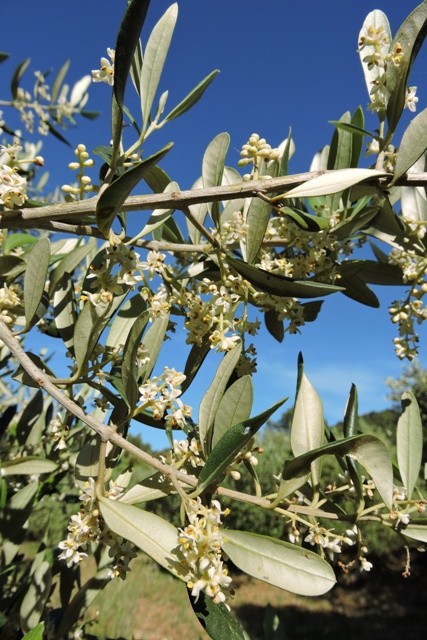
I have allowed a Passiflora caerulea to grow wild through one of my trees and up the wall of my workshop. Every day now it has a hundred or more flowers.
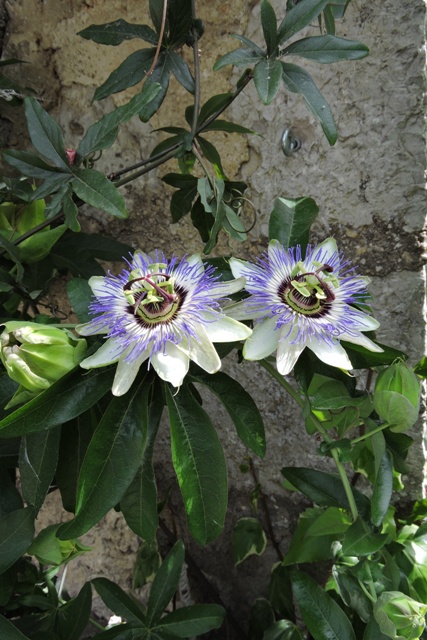
They only last a single day, but I should have a lot of fruit in the autumn.
De-nailing
There is an old saying that when the only tool that you have is a hammer, everything looks like a nail.
As the work in the Konoba has continued this week, I had a discussion with the builder Špiro, about the wooden beams. It started with him asking if I wanted to have the beams cleaned while they were doing the walls.
I had already thought of that, but I want to see what one looks like when it’s cleaned first. At the moment the old wooden beams have a patina and create an atmosphere of timelessness.
When the Konoba was rebuilt after being destroyed in WWII, the builders simply went up to the woods on the hill behind my home and cut a few pine trees down. These then became the ceiling timbers to support the floor above.
The same happened with roofing timbers, only using smaller trees. The diameter of the trees diminishes the higher up the building you go
Nothing was wasted back then, so because they do not have as much weight to bear there was no point in over engineering with bigger trees than they actually needed.
Because in times past the Konoba was a working area, everything that was needed was hung from nails in the beams.
When I moved in there were old brass syphons, coils of pipe, wires and other assorted oddities.
Close to the door there was a brass weighing scale, clearly where they had weighed outgoing (or incoming?) produce and goods.
Being wood, it was easy with a hammer to just knock another nail in when you wanted somewhere to hang something. Much easier than knocking a ail into stone.
Starting at one end, it was a couple of hours job with a long nail bar and a support block, to gently remove the nails in each beam. The support block prevented the nail bar from bruising the wooden beams.
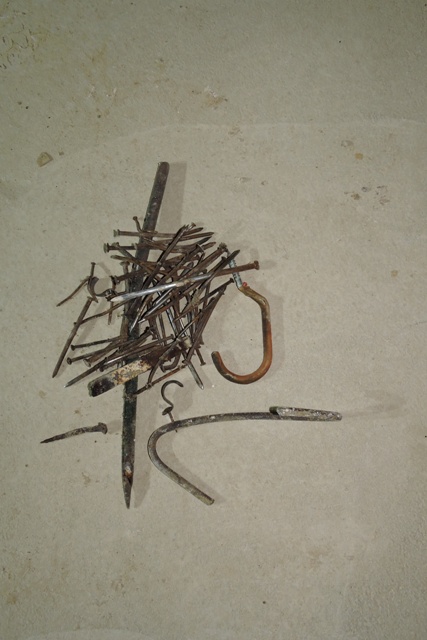
Almost all the nails are of modern origin. Just ordinary steel, gently corroding with age. There was just a single modern screw fixing, where a ladder had been hung from the ceiling.
In a couple of places there are much, much older hand forged blacksmith made nails.
Because of the donkeys, mules and the occasional horse, blacksmithing was a recognised trade. So it is not unexpected to find these old nails.
I have left most of these in place in the beams. Mainly because they are part of the history of the building, but also because of the wide, square shaft, they will leave a large hole once rmoved.
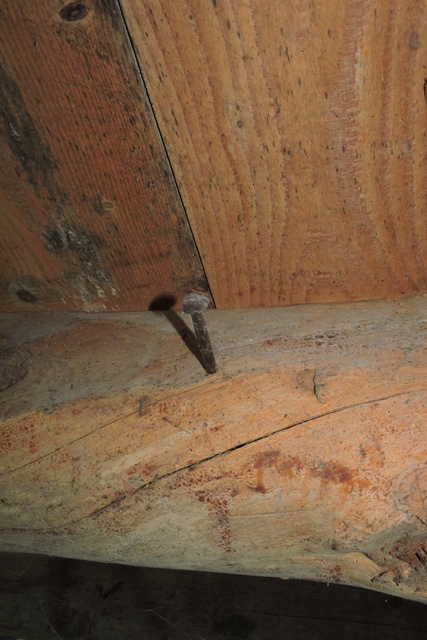
When I had finished the removal work, I collected all the various pieces of steel and they weighed close to two kilograms.
They went to the rubbish bins because on the island metal is not recycled.
Sand gets everywhere
The workmen started on Wednesday with cleaning the walls by sand blasting with silica sand.
I have a sand blast cabinet for cleaning small metal parts, so know how much dust is made with the process. When the dust is uncontained it just gets everywhere.
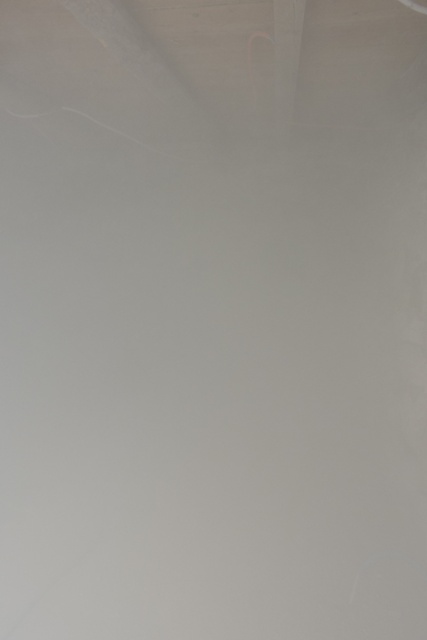
There was a large air compressor outside with two snaking hoses one going to a hopper which was regularly filled with sand, the other to a pressure regulator.
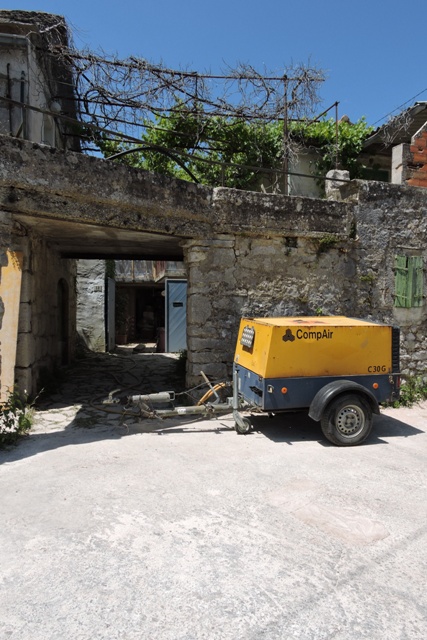
Basically once the hopper was pressurised, the air forced silica sand along a delivery pipe, and at the nozzle end a high pressure stream of air fired the sand at the stone walls.

The second low pressure line feeds continuous positive air pressure to the helmet and face mask of the operator

This was not a healthy working environment, even with full protective clothing.
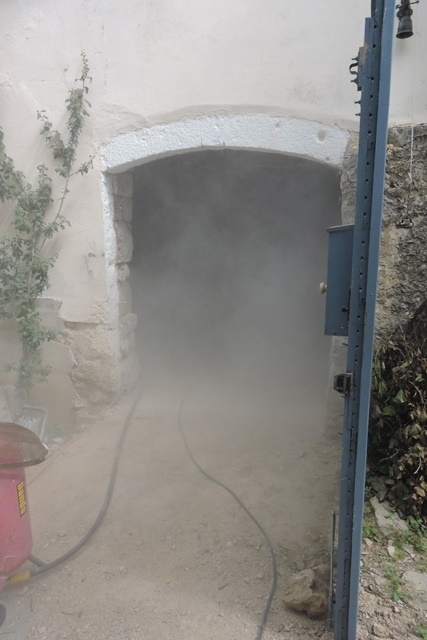
When I was remodelling and laying the new hardwood floor upstairs, I sealed all around the walls to stop draughts. I’m very pleased I did!
Outside a layer of grains of sand and dust as fine as talcum powder, covered everything in the courtyard.
At the end of the work, I had to wash down the trees and plants to get rid of the white layer from their leaves.
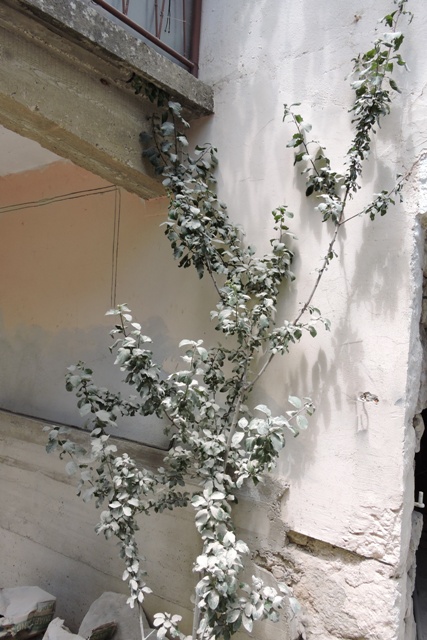
Hard going
There will be about a week before the builders return to point the stonework in the Konoba, however, it’s not a week off for me!
I have laid in the wiring that I need for sockets and the computer network because it is part of the ring main circuit for the building, but nothing has been let into the walls.
While the builders are on another job, I have to channel out the walls and let the wiring in, ready for the joints to all be pointed with mortar. That sounds easy, but I have already found it to be quite difficult.
My first full day was on Thursday. I started early at around 06:30. With sunrise being 05:20 and the days now getting hot in the middle of the day, I tend to be up around 5am and then start the day’s work early.
Once again this wiring demanded thought and planning. It’s not just making sure that the stairs will not block a wall socket, but also things like what height above the yet-to-be-built stairs, do I need the light switch to be?
There is a switched outside socket, so I can plug in Christmas lights in the courtyard, or perhaps coloured lights for a summer party. In addition, there are a pair of outside lights, one either side of the main doors, that need cable to be fed through the wall, once a hole has been bored through the stone.
I have tried to get a Mortar Rake, to help removed the old limestone mortar from between the stones. But you will already have guessed, they are just not available here.
I took a photo of what I wanted to the three builders merchants on this side of the island. BEPO in Jelsa suggested I use a wire brush.
There was a sharp intake of breath from the lady in Maestral, who shook her head.
Rosa at Volat said she had never seen one, but produced a thick catalogue of tools, checked the index and opened page 320.
There were some diamond tipped augers, of various diameters and she said she would order one for me to look at. I do like Volat, they are always helpful and eager to please.
The augers were not quite what I wanted, but might work. However the time delay between ordering and arrival meant that I needed an alternative option.
In one of my tool boxes I found an old masonry drill with a broken tip. I’m not sure why I kept it, because without the tip it is pretty much useless, but it gave me an idea.
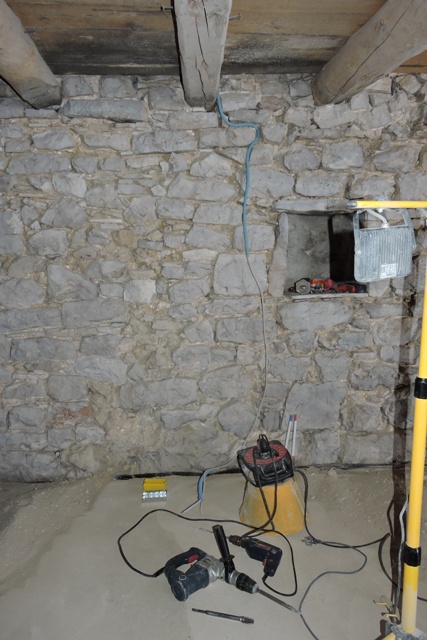
Using my old Kress electric drill, and this bit as an auger, I tried to remove some of the mortar between the stones. It worked, but only because the mortar was made with limestone and sand, so it is extremely soft and just crumbles away.
Finally, some progress
At the end of the first day’s work, I had little progress to show for my efforts
It was hard work trying to select the path for the wires to take and that was before I even started to remove any old mortar.
Removing the mortar was relatively straight forward and my improvised Mortar Rake worked on the soft lime pointing.
One of the difficulties was and is where to actually locate the pattress boxes. These are the rigid containers which are securely fixed into a wall, and where the socket you plug into goes.
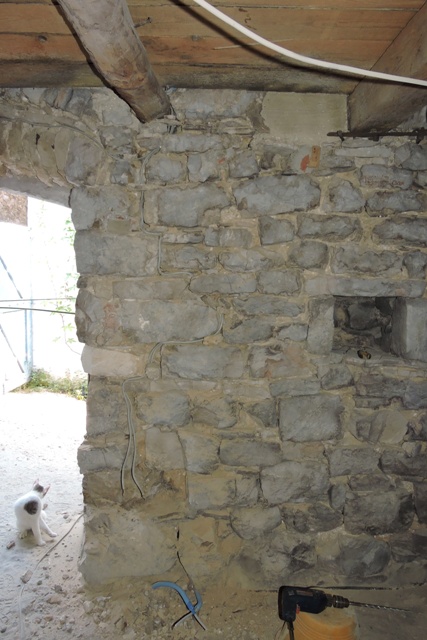
Being extremely random stone, trying to find a large enough space for a pattress box, at the right height, is not easy.
Another part of the problem was that I started with perhaps the most difficult wires.
The essence of a ring main, is that a single wire runs from pattress box to pattress box, rather than a large number of radial wires running all over, like the roots of a plant, to the furthest points.
In this place, I had two cables, not one, to fit into the walls. However I did manage the task in the end.
By Saturday, I had run four of the eight cables. When a wire was fitted in between the stones, once the pointing has been done, you will never know the wire is there.
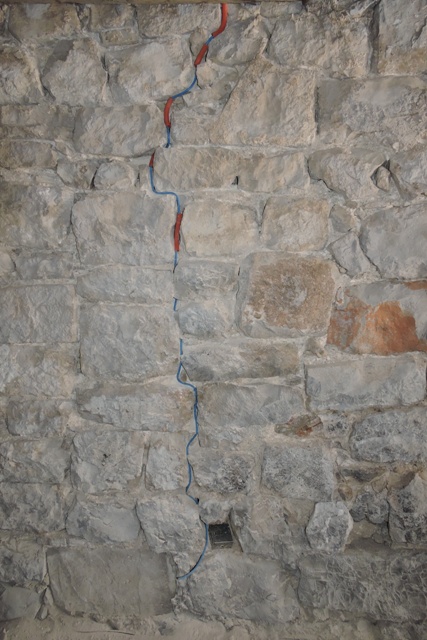
The burning of Dol – Evidence of the fire
I’ve mentioned in a past blog about the day when my buildings were burnt to the ground, along with the 34 other properties in the two villages of Dol.
As I was routing the new wiring in the Konoba, I saw the blackened ends of several pieces of wood, which were sticking out from between the stones above the doorway.
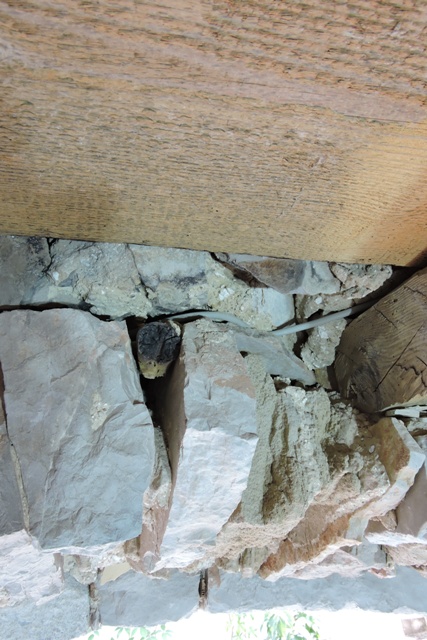
I’ve never noticed these pieces before, as they were covered with dust and had merged with the stonework. It is only the cleaning this week that has revealed them.
It is another reminder of the attack by Italian Facista forces on Sunday 3rd January, 1943.
Terrible things happen during all wars, and the 1939-1945 conflict was no different.
The Italian army under the dictator Benito Mussolini joined the axis powers in 1940. They invaded the then Kingdom of Yugoslavia which covered much of the Balkans.
On 6 April 1941, the Wehrmacht invasions of Yugoslavia (Operation 25) and Greece (Operation Marita) both started. Together with the rapid advance of the German forces the Italians attacked Yugoslavia in Dalmatia and pushed the Greeks out of Albania.
On 17th April 1941, the Kingdom of Yugoslavia surrendered to the Germans and the Italians. On 30th April, Greece too surrendered to the Germans and Italians, and was divided into German, Italian and Bulgarian sectors. The invasions ended with a complete Axis victory in May when Crete fell.
Some 28 Italian army divisions participated in the Balkan invasions.
Coastal Yugoslavia was occupied by the Italian Army, while the rest of the country was divided between the Axis forces (a German and Italian puppet State of Croatia was created, under the nominal sovereign of an Italian Savoia).
Italian troops would occupy parts of Greece and Yugoslavia until the Italian armistice with the Allies in September 1943. Their occupation was especially brutal.
However their occupation was heavily contested by various partisan groups.

A column of the Fourth Battalion of the First Dalmatian Partisans moves to a position near Rudina, above Stari Grad, September 1943 – Dol nestles in the hill in the background. Yugoslav Partisans fought a guerrilla war against the occupying forces until 1945.
On Hvar there was an Italian Garrison in Stari Grad, which included a group of ‘Camicie Nere’ the armed squads of Italian Fascists under Benito Mussolini, who wore black shirts as part of their uniform.
Many of the island’s population had been deported to internment camps in Egypt (then also under Italian control).
The chief role of the ‘Camicie Nere’ in occupied territories was partisan suppression.
There had been a partisan attack on Italian soldiers in the vicinity of Dol, sometime between Christmas and New Year 1943. Early on the morning of the 3rd January 1943, the Camicie Nere left Stari Grad and headed for Dol and Vrbanj.
During the incident over New Year – one of many – when partisans, who were supported by villagers in Dol, Vrbanj, Borovik and Svrče, had killed some members of the Italian military.
Around 5am on the 3rd January, villagers were awoken by the sounds of tanks, vehicles and shots being fired.
A so called “Punishment raid” on the villages had been organised. The Italian Facista went from house to house, looting as they went and setting fire to every building.
Soon columns of black smoke could be seen rising above Dol Sv. Ana, then Dol Sv. Maria and later Vrbanj as the Camicie Nere sought to punish the local population for the work of the partisans.
Some residents who were fleeing into the forest were shot, being mistaken for Yugoslav Partisans. Almost every home in Dol was burned and five residents were killed.
When I bought my home, I was told by the owner, who was a teenager during the war, that he and his mother had to flee as the house was burnt.
This is the reason that the big Konoba has concrete tiles on the roof – they were provided as war reparations.
All three of my main buildings were involved in the attack by the Camicie Nere.
Throughout the occupied Balkan territories, the Italians were harried at every opportunity by partisans.
After leaving Dol, the Camicie Nere went to Vrbanj and then Borovik.
Most buildings were repaired and rendered habitable again, except for those in Borovic. The village, up the hill from Dol was abandoned and has slowly been reclaimed by the Maquis.
The story was recorded in the Dol village school log, and also in the Croatian Gendarmerie records in Stari Grad.
The official records were transcribed and published in 5th Issue of the Village magazine, Tartajun, and is also on the Tartajun web page and in English on the Topohvar web page.
A memorial to one of my immediate neighbours, one of the five people killed during the raid, stands on the road between Dol and Vrbanj.
Like all the houses in this part of the village, mine was owned by members of the extended Roić family.

The inscription on the carved stone reads:
Za vrijeme paljenja ……………. During the burning
mjesta Dola ……………………… of Dol
okupator strelja ovde …………. the occupiers shot here
nevinu žrtvu ……………………… an innocent victim
Matu Roić pok Luke
28.IV.1887 – 3. I. 1943 ………… [56 years]
Iz ljubavi podižu …………………. Out of love from the
rastužena djeca …………………. saddened children
Luka, Fabijan i Katica …………. Luka, Fabijan and Katica
For this reason, I will be keeping these small pieces of burnt timber, and making sure they are visible, because they are so much a part of the history of my home here in Dol.
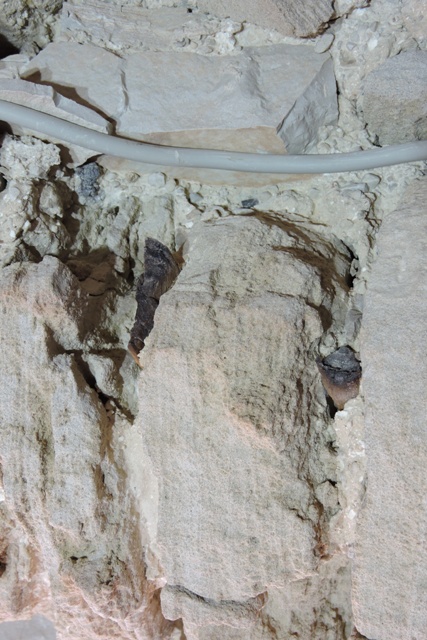
Only two left
The Madonna Lilies, Lilium candidum, have come into flower this week, a little later than in previous years.

At the same time, the switch has been thrown and summer temperatures have suddenly arrived.
It’s only last week that I needed a light cardigan because of the cold wind. This week I need air conditioning as the temperature rapidly heads towards 30ºC.
Madonna lilies are an indicator species on my Springwatch calendar.
The lilies are in a large clump by the side of the path up to the Donkey track and appear without fail every year. This means that they are easy to observe and record when the first flowers appear.
There are only two species left for me to complete this year’s calendar.
Because of the cool damp weather, the Tiger Mosquito is late putting in an appearance, I’m pleased to say, and the final species every summer is the first Circada.
In the Mediterranean, the Circadas are an annual species, unlike their North American Periodic cousins which appear only once every 17 years.
This year there has been a lot in the media about the millions of Cicadas of Brood X which are hatching along the eastern seaboard of the United States, because 2021 is the 17th year in the cycle.
Here they are an annual species, which have the same lifecycle, living underground over winter, until emerging in early summer and then becoming a constant background sound to the Mediterranean biome.
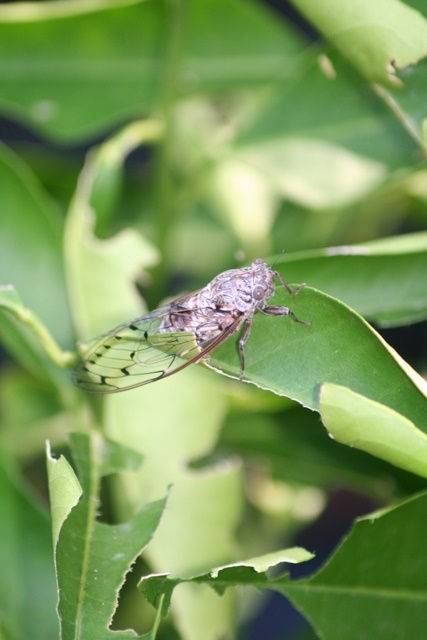
I have not had time to properly evaluate how early or late all the species are this year.
However looking at the raw figures, most things are early, some the same as previous years and just one or two are later than average by a few days to a week.
This is a longitudinal study, so its value will increase as the years go by and patterns start to emerge.
At the moment, with only five years of data it is too early to say with any certainly what changes there are in the appearance of species each spring.
This is the time of year when all kinds of interesting insects are emerging from their pupa stage. There are large numbers of butterflies and moths, including this beautiful Cream Spot Tiger Moth, Epicallia villica.

Close to my main door I have a large white Jasmine plant. It is covered in flowers at the moment and their scent lingers near to the plant, all day long. NCG
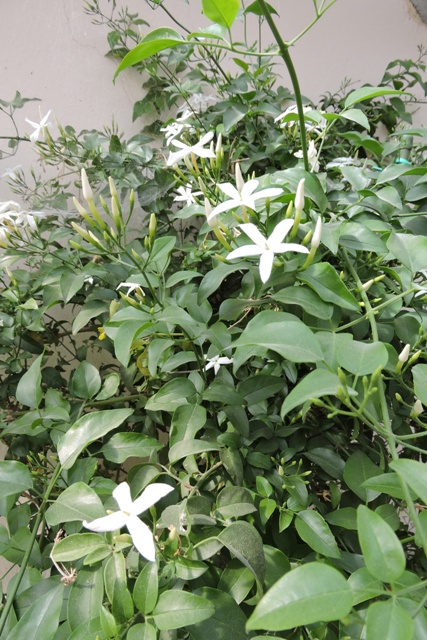
Looking back – Week 21
This is the start of a new weekly section, with links to past issues of the blog.
2015/21 A hole has appeared and the builders are looking into it!
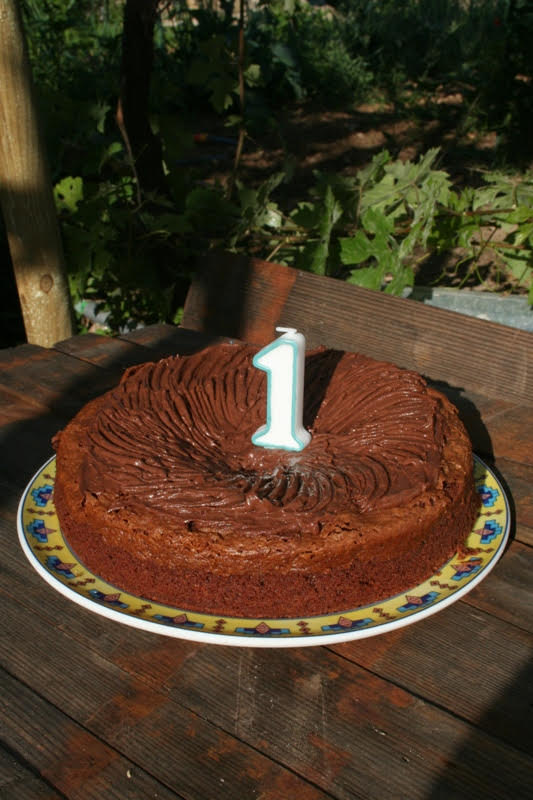
2016/21 Roll out those lazy, hazy, crazy days of summer
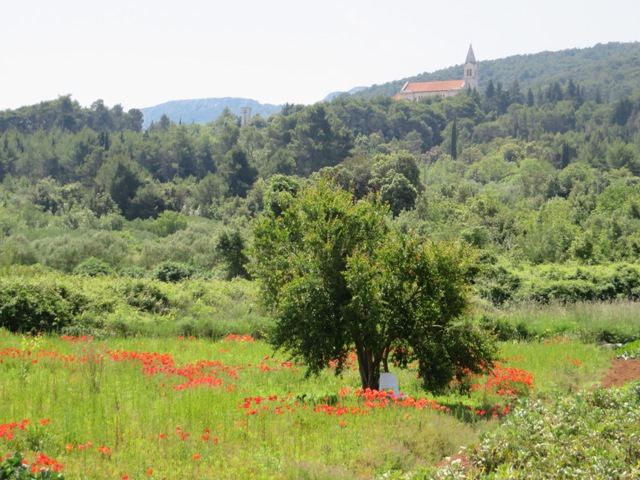
2017/21 Do you speak Human?

2018/21 Adapting to climate change

2019/21 Weeds, weeds, weeds….

2020/21 Hindsight
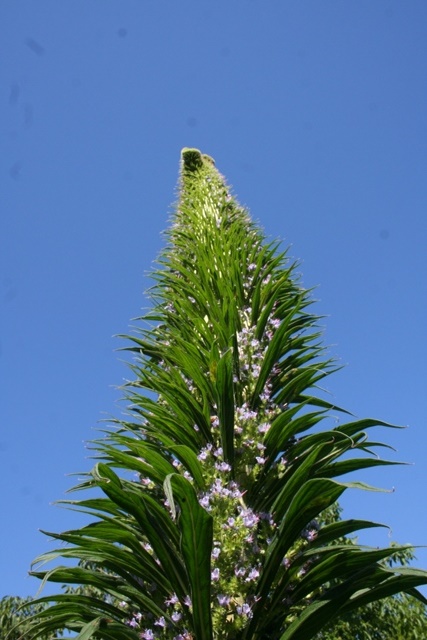
3 Responses
Jonathan McAuley
Hi Norman
Thanks again for an interesting update.
Jonathan
Michael Southall
Hi Norman,
Steve’s pal Mike here. Your Tiger Moth is the Cream-spot Tiger, Arctia villica.
Best Regards
Mike
Brian Graham
Norman,
Excellent historical input about WW2. It was both informative and interesting. I do hope that you are keeping well and enjoying life. Regards, Brian G